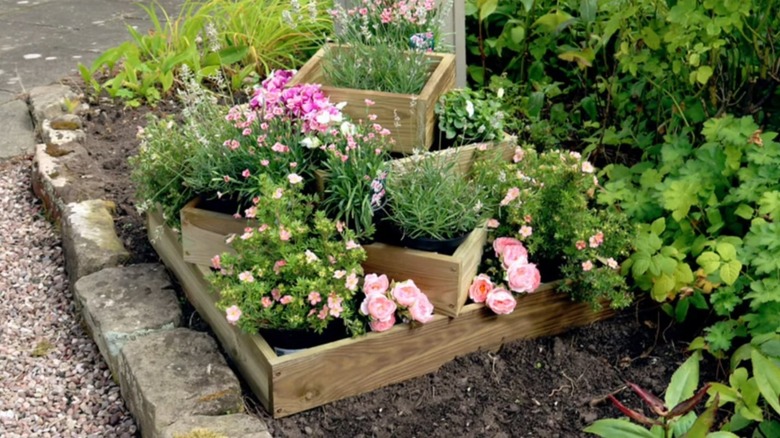Raised garden beds are a genius way to make your backyard more hospitable to gardening, especially if you live in an area with swampy clay soil or thick bedrock. Whether you’re installing your first raised garden beds or adding a few new ones to your layout, it’s easy to fall into the pattern of boring rectangular boxes. These standard boxes work just fine, but they won’t do much to improve the aesthetics and visual interest of your outdoor space.
Instead, think outside the box with a tiered diamond garden bed. A TikTok shared by HGTV shows exactly how to make one. All you need to do is build three or more boxes, each one slightly smaller than the other, and stack them on each other to create a unique tiered garden bed.
Whether you have a small-scale backyard operation or a whole farm, diamond garden beds are a clever way to build a flourishing vegetable garden. Here’s what you’ll need to make your own diamond garden bed, the benefits of this raised garden style, and some tips for what to plant in your glamorous new garden.
Designing and building your diamond boxes
Like ✨diamonds✨ in a garden #raisedbedgarden #gardentok
♬ Aesthetic – Tollan Kim
First, decide how large you would like the base of your diamond garden bed to be, as each square in the tier will need to nest inside the square below it. For example, if you want the base of your garden bed to be 4 feet on each side, your next square should be about 3 feet on each side, and so on. Depending on what you’d like to plant, 6 inches is a good minimum depth for a raised garden bed, so 2 by 6-inch boards should be sufficient for this project. Remember that the second tier will actually have 12 inches of soil and the third tier will have 18 inches.
To build perfect squares, cut your 2 by 6-inch boards to the desired lengths, set them upright, and press the ends against each other to create corners. Use wood glue or drill screws to hold them in place. After you’ve built all your boxes, place the bottom box at the desired location in your yard and fill it with garden soil.
Set the second box on top of the bottom box at an angle, creating four triangular corners for planting in tier one. Fill the second box with soil, then place the third box on top, parallel to the first box, creating four plantable corners in tier two. Fill the third box with soil, then water the entire garden bed to help everything settle in before planting.
Backyard beauty with benefits

@ZestOutdoorLiving/YouTube
For such a simple project, this diamond planter box has some stunning results. But growing diamonds in your garden is more than just a beautiful image — these planter designs have some serious benefits. The miniboxes created by each corner keep plants separated so they won’t have to compete for root space.
Excess water trickles down from each tier, reducing water waste and ensuring that the soil has good drainage. Finally, this tall raised bed is easier to maintain, providing access to each plant without having to reach through or step over the garden. For extra protection against weeds, you can even staple a landscape fabric barrier to the bottom box before filling it with soil.
Because each tier in the raised diamond bed has a different soil depth, you can grow a variety of plants in one location. Place shallow-rooted plants like fresh herbs, cabbages, or radishes in the bottom planter corners and deeper-rooted varieties like carrots, peppers, and peas in the upper boxes. If you’re looking to add more aesthetic value to your outdoor space, these diamond garden beds look amazing with color-coordinated flower combinations.




